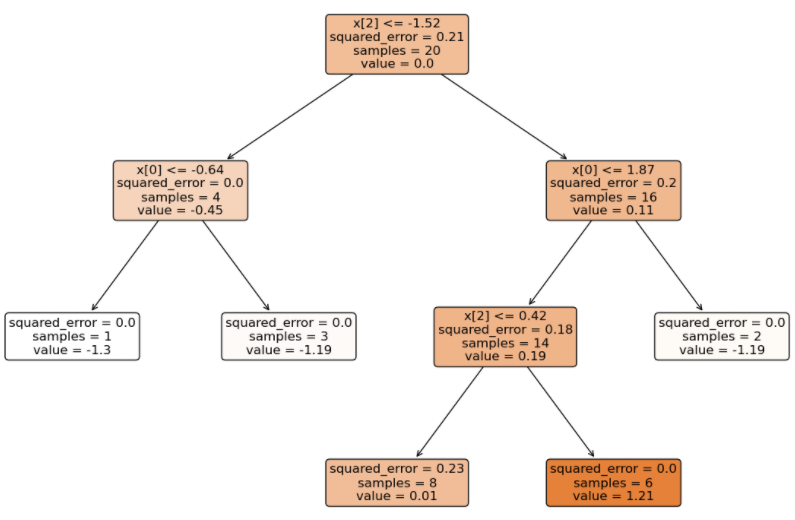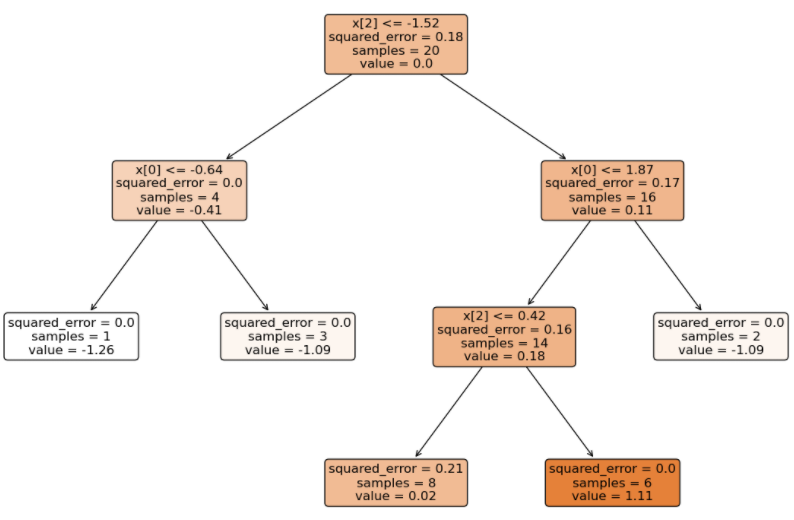GBDT(Gradient Boosting Decision Tree,梯度提升树)本质上是一个二分类模型。它通过不断迭代地拟合前一轮模型的负梯度,逐步提升模型的预测精度。在二分类任务中,GBDT 结合 Sigmoid 函数 输出类别概率。
然而,在实际任务中,我们经常会遇到多分类问题。GBDT 并不能直接处理多类别标签,因此需要借助一种常见的扩展策略:OVR(One-vs-Rest,一对多),OVR 思想如下:
假设训练数据中有 K 个类别(例如:0、1、2),那么我们就训练 K 个独立的二分类 GBDT 模型:
- 模型 0:用于区分类别 0 和非 0 类
- 模型 1:用于区分类别 1 和非 1 类
- 模型 2:用于区分类别 2 和非 2 类
在预测时,将样本分别送入这 K 个模型中,得到 K 个分数,这 K 个分数就表示该样本属于不同类别的分数,最后使用 Softmax 函数 将这些分数归一化为概率:

接下来,我们通过一个具体的计算案例来加深对 GBDT 应用多分类过程的理解。

假设:数据集中有 20 条数据, 50% 为 0 标签,30% 为 1 标签,20% 为 2 标签。接下来使用 GBDT 预测新样本:[0.49671415 -0.1382643 0.64768854] 的类别标签。
每个 GBDT 模型在训练前都有一个初始分数,这个分数反映了类别的先验概率。由于多分类使用 Softmax 函数(二分类使用的是 sigmoid 函数),因此初始分数可通过对数计算:

代入数据得到:
| 类别 | 占比 (\(p_{k}\)) | 初始分数(\(F_{k}^{0}\)) |
|---|---|---|
| 0 | 0.5 | -0.6931471805599453 |
| 1 | 0.3 | -1.2039728043259361 |
| 2 | 0.2 | -1.6094379124341003 |
由于是多分类,GBDT 得到的模型结构(3 个二分类 GBDT 分类器)如下:









将待预测的样本分别输入到不同类别的 GBDT 中得到分数(学习率 0.1):
- 输入到 0 类别 GBDT 得到的分数总和:(1.33 + 1.21 + 1.11) * 0.1 = 0.365
- 输入到 1 类别 GBDT 得到的分数总和:(-0.73 – 0.69 – 0.66) * 0.1 = -0.208
- 输入到 2 类别 GBDT 得到的分数总和:(-0.83 – 0.81 – 0.79) * 0.1 = -0.243
再分别加上属于不同类别的初始分数:
- 属于 0 类别分数:-0.6931471805599453 + 0.365 = -0.3281471805599453
- 属于 1 类别分数:-1.2039728043259361 – 0.208 = -1.411972804325936
- 属于 2 类别分数:-1.6094379124341003 – 0.243 = -1.8524379124341004
最后使用 Softmax 得到输出不同类别的概率:
- 属于 0 类别的概率:0.64
- 属于 1 类别的概率:0.22
- 属于 2 类别的概率:0.14
最后将输入样本归类到 0 类别。
from sklearn.ensemble import GradientBoostingClassifier
from sklearn.datasets import make_classification
import numpy as np
import matplotlib.pyplot as plt
from sklearn.tree import plot_tree
# 生成随机数据
x, y = make_classification(n_samples=20,
n_classes=3,
n_features=3,
n_redundant=0,
n_informative=3,
n_repeated=0,
weights=[0.5, 0.3, 0.2],
random_state=42)
# 训练分类模型
gbdt = GradientBoostingClassifier(n_estimators=3,
criterion='squared_error',
loss='log_loss')
gbdt.fit(x, y)
# 可视化 GBDT
for estimators in gbdt.estimators_:
plt.figure(figsize=(50, 10))
for idx, estimator in enumerate(estimators):
plt.subplot(1, 3, idx + 1)
plot_tree(estimator, filled=True, rounded=True, fontsize=12, precision=2)
plt.show()
# 新数据预测
np.random.seed(42)
new_x = np.random.randn(1, 3)
print('输入的新样本数据:', new_x)
# 直接计算类别概率
print('直接计算类别概率:', gbdt.predict_proba(new_x)[0])
# 分布计算类别概率
def test():
# 1. 初始得分
total_score = [np.log(0.5), np.log(0.3), np.log(0.2)]
# 2. 累加每个树的得分
learning_rate = 0.1
for estimator in gbdt.estimators_:
# 计算每一个类别的得分
for idx, est in enumerate(estimator):
# 每棵树计算得分
score = estimator[idx].predict(new_x)
# 累加每棵树得分
total_score[idx] += score * learning_rate
# 3. 将得分输出概率
def sofmax(x):
numerator = np.exp(x).reshape(-1)
denominator = sum(numerator)
return numerator / denominator
print('分步计算类别概率:', sofmax(total_score))
if __name__ == '__main__':
test()
程序输出结果:
输入的新样本数据: [[ 0.49671415 -0.1382643 0.64768854]] 直接计算类别概率: [0.64261892 0.21755397 0.13982711] 分步计算类别概率: [0.64261892 0.21755397 0.13982711]

 冀公网安备13050302001966号
冀公网安备13050302001966号